FRANU NURS 3340: ED Crowding Effect on Patient Outcomes Review
VerifiedAdded on 2023/04/23
|8
|2051
|316
Literature Review
AI Summary
This paper examines the impact of emergency department (ED) crowding on patient outcomes, a critical issue in healthcare. It highlights that ED crowding, defined as a mismatch between patient needs and available resources, leads to adverse outcomes such as delays in care, increased medical errors, and higher mortality rates. The review synthesizes evidence from various studies, identifying factors contributing to crowding, including inpatient bed limitations, increased patient volume, and staffing shortages. Effective strategies to mitigate crowding, such as fast-track systems, dedicated patient flow coordinators, and bed management strategies, are discussed. The paper proposes using evidence-based practices to optimize ED services, improve patient flow, and enhance the quality of care, emphasizing the need for a multidisciplinary, system-wide approach to address this complex problem. It concludes that alleviating ED crowding is essential for ensuring patient safety and improving healthcare delivery.

1
The Effect of Emergency Department Crowding on Patient Outcomes
The Effect of Emergency Department Crowding on Patient Outcomes
Name of the Student
Name of the university
Author’s note
The Effect of Emergency Department Crowding on Patient Outcomes
The Effect of Emergency Department Crowding on Patient Outcomes
Name of the Student
Name of the university
Author’s note
Paraphrase This Document
Need a fresh take? Get an instant paraphrase of this document with our AI Paraphraser
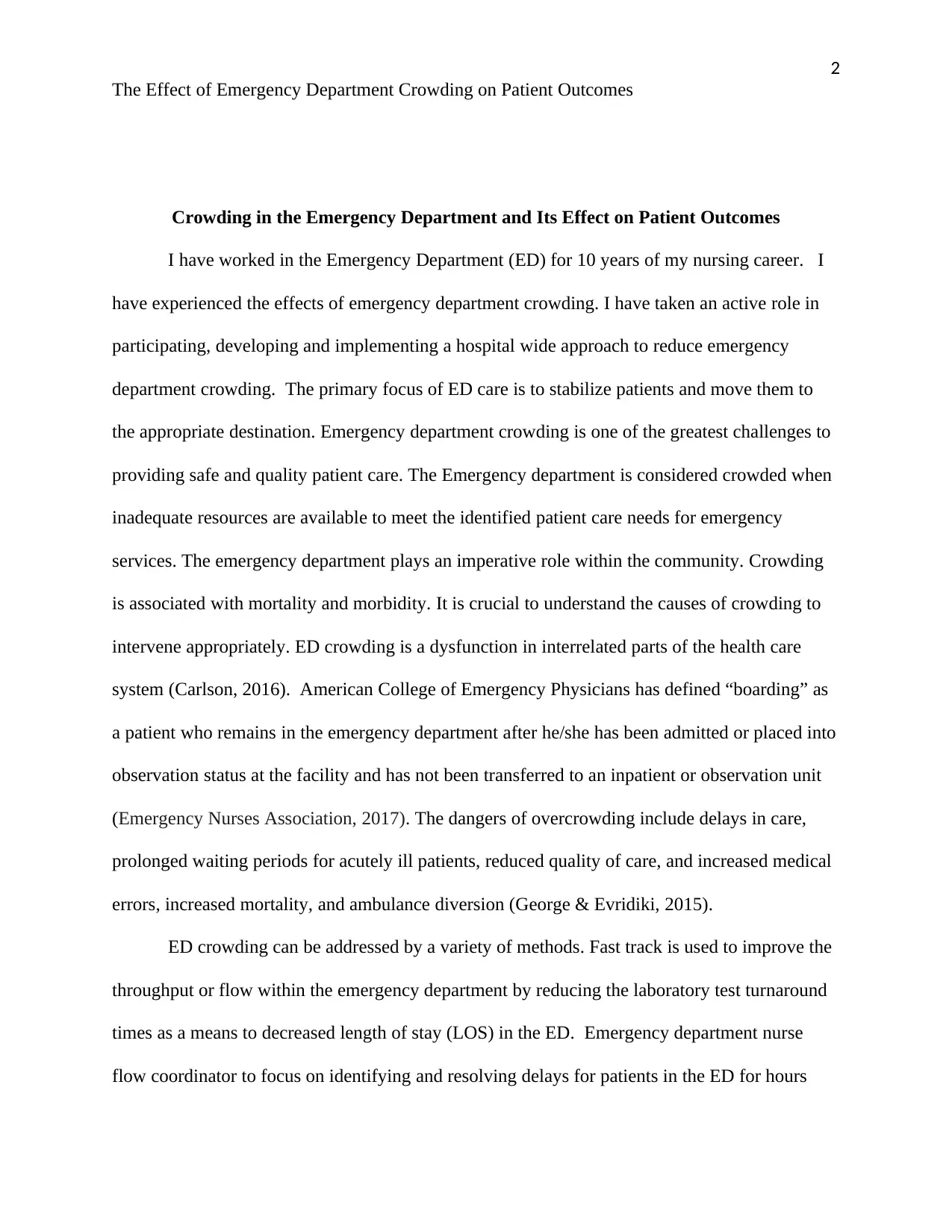
2
The Effect of Emergency Department Crowding on Patient Outcomes
Crowding in the Emergency Department and Its Effect on Patient Outcomes
I have worked in the Emergency Department (ED) for 10 years of my nursing career. I
have experienced the effects of emergency department crowding. I have taken an active role in
participating, developing and implementing a hospital wide approach to reduce emergency
department crowding. The primary focus of ED care is to stabilize patients and move them to
the appropriate destination. Emergency department crowding is one of the greatest challenges to
providing safe and quality patient care. The Emergency department is considered crowded when
inadequate resources are available to meet the identified patient care needs for emergency
services. The emergency department plays an imperative role within the community. Crowding
is associated with mortality and morbidity. It is crucial to understand the causes of crowding to
intervene appropriately. ED crowding is a dysfunction in interrelated parts of the health care
system (Carlson, 2016). American College of Emergency Physicians has defined “boarding” as
a patient who remains in the emergency department after he/she has been admitted or placed into
observation status at the facility and has not been transferred to an inpatient or observation unit
(Emergency Nurses Association, 2017). The dangers of overcrowding include delays in care,
prolonged waiting periods for acutely ill patients, reduced quality of care, and increased medical
errors, increased mortality, and ambulance diversion (George & Evridiki, 2015).
ED crowding can be addressed by a variety of methods. Fast track is used to improve the
throughput or flow within the emergency department by reducing the laboratory test turnaround
times as a means to decreased length of stay (LOS) in the ED. Emergency department nurse
flow coordinator to focus on identifying and resolving delays for patients in the ED for hours
The Effect of Emergency Department Crowding on Patient Outcomes
Crowding in the Emergency Department and Its Effect on Patient Outcomes
I have worked in the Emergency Department (ED) for 10 years of my nursing career. I
have experienced the effects of emergency department crowding. I have taken an active role in
participating, developing and implementing a hospital wide approach to reduce emergency
department crowding. The primary focus of ED care is to stabilize patients and move them to
the appropriate destination. Emergency department crowding is one of the greatest challenges to
providing safe and quality patient care. The Emergency department is considered crowded when
inadequate resources are available to meet the identified patient care needs for emergency
services. The emergency department plays an imperative role within the community. Crowding
is associated with mortality and morbidity. It is crucial to understand the causes of crowding to
intervene appropriately. ED crowding is a dysfunction in interrelated parts of the health care
system (Carlson, 2016). American College of Emergency Physicians has defined “boarding” as
a patient who remains in the emergency department after he/she has been admitted or placed into
observation status at the facility and has not been transferred to an inpatient or observation unit
(Emergency Nurses Association, 2017). The dangers of overcrowding include delays in care,
prolonged waiting periods for acutely ill patients, reduced quality of care, and increased medical
errors, increased mortality, and ambulance diversion (George & Evridiki, 2015).
ED crowding can be addressed by a variety of methods. Fast track is used to improve the
throughput or flow within the emergency department by reducing the laboratory test turnaround
times as a means to decreased length of stay (LOS) in the ED. Emergency department nurse
flow coordinator to focus on identifying and resolving delays for patients in the ED for hours

3
The Effect of Emergency Department Crowding on Patient Outcomes
would reduce crowding (Carlson, 2016) . A bed management strategy to alleviate ED crowing
should be evaluated and implemented. Surge levels are criteria based on unique needs in house.
Surges are communicated by overhead paging system through the hospital and emails to notify
the administration and ED management team. The plan is effective in decreasing length of stay
in the emergency department. ED crowding has a negative impact on nurses including high
turnover, burnout, increased workload, stress, increased violence exposure, and non-adherence
to best practice guidelines. The nursing shortage often causes hospitals to close available
inpatient beds. ED crowding effects the practice of the emergency nurse and has become a daily
challenge to providing high quality patient care in the ED. Several factors contribute to ED
crowding such as nursing staff shortages, decreased inpatient beds, increased patient volume,
delays in diagnostic imaging and laboratory results and increased acuity of patient in the ED.
Synthesis of Evidence
A wealth of literature exists, that demonstrates consequences of crowding in the
Emergency department. As stated by McHugh, Van Dyke, McClelland, and Moss (2011),
"Nearly half of ED’s report, operating at or above capacity. 9 out of 10 hospitals report holding
or “boarding” admitted patients in the ED while they await inpatient beds.” A contributing
factor to ED crowding is the challenge of admitting patients and moving them to inpatient beds.
The primary reason for emergency department crowding is limitation of inpatient hospital beds.
Emergency department overcrowding is a public health crisis in the United States (US).
Crowding poses a great threat to patient safety ranging from extended length of stay to medical
errors. Building an understanding of how emergency department crowding affects the practice
of the emergency nurse is essential to examine, how nursing care, observation, and
The Effect of Emergency Department Crowding on Patient Outcomes
would reduce crowding (Carlson, 2016) . A bed management strategy to alleviate ED crowing
should be evaluated and implemented. Surge levels are criteria based on unique needs in house.
Surges are communicated by overhead paging system through the hospital and emails to notify
the administration and ED management team. The plan is effective in decreasing length of stay
in the emergency department. ED crowding has a negative impact on nurses including high
turnover, burnout, increased workload, stress, increased violence exposure, and non-adherence
to best practice guidelines. The nursing shortage often causes hospitals to close available
inpatient beds. ED crowding effects the practice of the emergency nurse and has become a daily
challenge to providing high quality patient care in the ED. Several factors contribute to ED
crowding such as nursing staff shortages, decreased inpatient beds, increased patient volume,
delays in diagnostic imaging and laboratory results and increased acuity of patient in the ED.
Synthesis of Evidence
A wealth of literature exists, that demonstrates consequences of crowding in the
Emergency department. As stated by McHugh, Van Dyke, McClelland, and Moss (2011),
"Nearly half of ED’s report, operating at or above capacity. 9 out of 10 hospitals report holding
or “boarding” admitted patients in the ED while they await inpatient beds.” A contributing
factor to ED crowding is the challenge of admitting patients and moving them to inpatient beds.
The primary reason for emergency department crowding is limitation of inpatient hospital beds.
Emergency department overcrowding is a public health crisis in the United States (US).
Crowding poses a great threat to patient safety ranging from extended length of stay to medical
errors. Building an understanding of how emergency department crowding affects the practice
of the emergency nurse is essential to examine, how nursing care, observation, and
⊘ This is a preview!⊘
Do you want full access?
Subscribe today to unlock all pages.

Trusted by 1+ million students worldwide
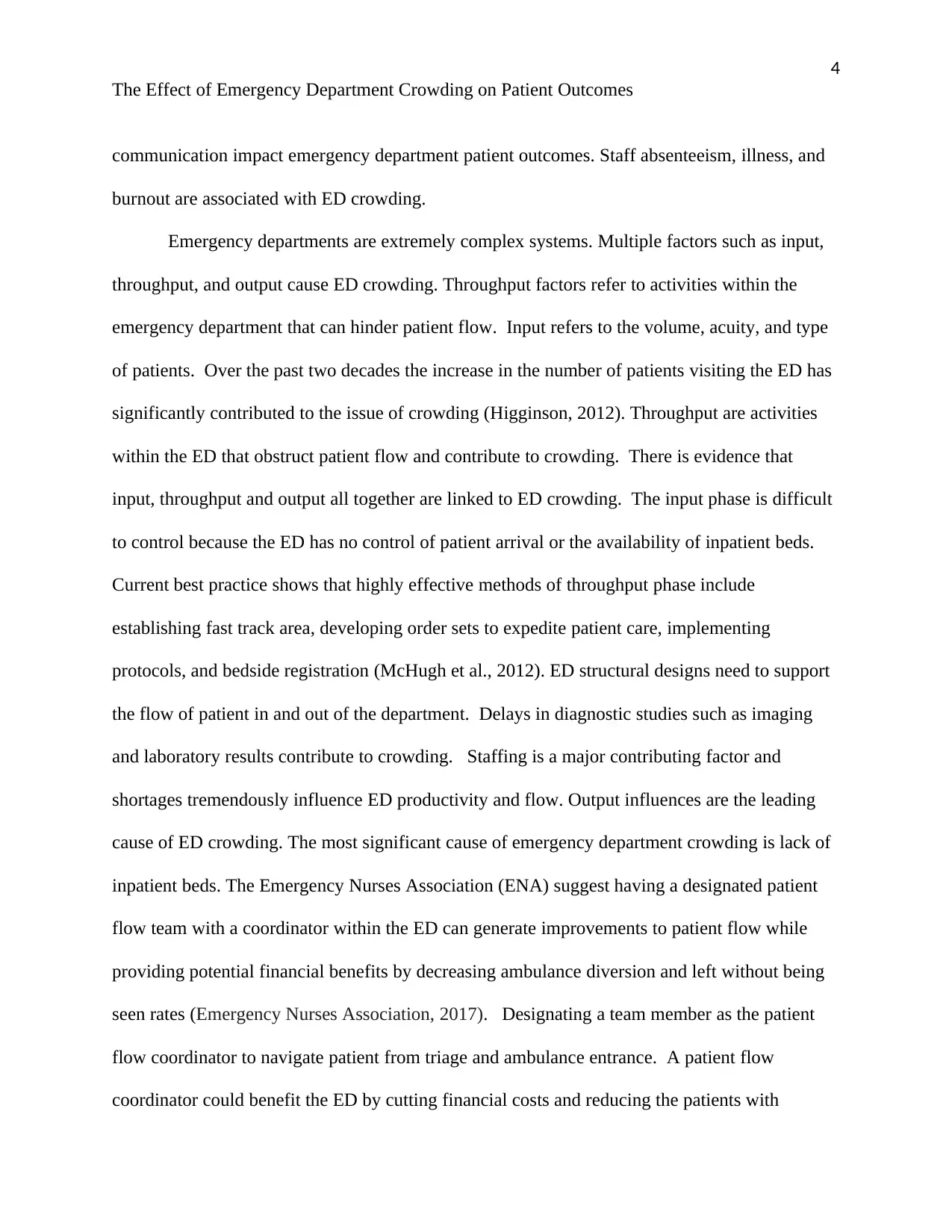
4
The Effect of Emergency Department Crowding on Patient Outcomes
communication impact emergency department patient outcomes. Staff absenteeism, illness, and
burnout are associated with ED crowding.
Emergency departments are extremely complex systems. Multiple factors such as input,
throughput, and output cause ED crowding. Throughput factors refer to activities within the
emergency department that can hinder patient flow. Input refers to the volume, acuity, and type
of patients. Over the past two decades the increase in the number of patients visiting the ED has
significantly contributed to the issue of crowding (Higginson, 2012). Throughput are activities
within the ED that obstruct patient flow and contribute to crowding. There is evidence that
input, throughput and output all together are linked to ED crowding. The input phase is difficult
to control because the ED has no control of patient arrival or the availability of inpatient beds.
Current best practice shows that highly effective methods of throughput phase include
establishing fast track area, developing order sets to expedite patient care, implementing
protocols, and bedside registration (McHugh et al., 2012). ED structural designs need to support
the flow of patient in and out of the department. Delays in diagnostic studies such as imaging
and laboratory results contribute to crowding. Staffing is a major contributing factor and
shortages tremendously influence ED productivity and flow. Output influences are the leading
cause of ED crowding. The most significant cause of emergency department crowding is lack of
inpatient beds. The Emergency Nurses Association (ENA) suggest having a designated patient
flow team with a coordinator within the ED can generate improvements to patient flow while
providing potential financial benefits by decreasing ambulance diversion and left without being
seen rates (Emergency Nurses Association, 2017). Designating a team member as the patient
flow coordinator to navigate patient from triage and ambulance entrance. A patient flow
coordinator could benefit the ED by cutting financial costs and reducing the patients with
The Effect of Emergency Department Crowding on Patient Outcomes
communication impact emergency department patient outcomes. Staff absenteeism, illness, and
burnout are associated with ED crowding.
Emergency departments are extremely complex systems. Multiple factors such as input,
throughput, and output cause ED crowding. Throughput factors refer to activities within the
emergency department that can hinder patient flow. Input refers to the volume, acuity, and type
of patients. Over the past two decades the increase in the number of patients visiting the ED has
significantly contributed to the issue of crowding (Higginson, 2012). Throughput are activities
within the ED that obstruct patient flow and contribute to crowding. There is evidence that
input, throughput and output all together are linked to ED crowding. The input phase is difficult
to control because the ED has no control of patient arrival or the availability of inpatient beds.
Current best practice shows that highly effective methods of throughput phase include
establishing fast track area, developing order sets to expedite patient care, implementing
protocols, and bedside registration (McHugh et al., 2012). ED structural designs need to support
the flow of patient in and out of the department. Delays in diagnostic studies such as imaging
and laboratory results contribute to crowding. Staffing is a major contributing factor and
shortages tremendously influence ED productivity and flow. Output influences are the leading
cause of ED crowding. The most significant cause of emergency department crowding is lack of
inpatient beds. The Emergency Nurses Association (ENA) suggest having a designated patient
flow team with a coordinator within the ED can generate improvements to patient flow while
providing potential financial benefits by decreasing ambulance diversion and left without being
seen rates (Emergency Nurses Association, 2017). Designating a team member as the patient
flow coordinator to navigate patient from triage and ambulance entrance. A patient flow
coordinator could benefit the ED by cutting financial costs and reducing the patients with
Paraphrase This Document
Need a fresh take? Get an instant paraphrase of this document with our AI Paraphraser
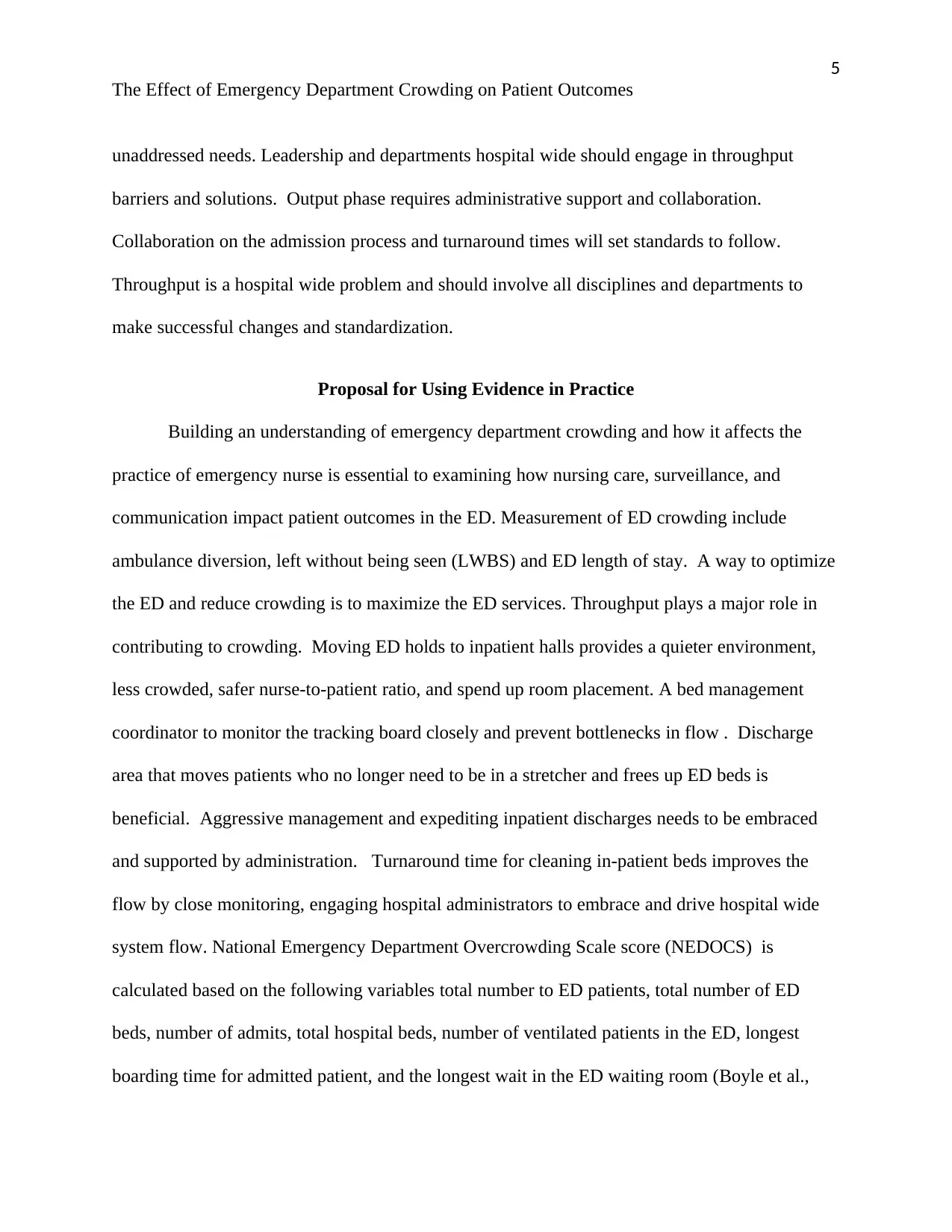
5
The Effect of Emergency Department Crowding on Patient Outcomes
unaddressed needs. Leadership and departments hospital wide should engage in throughput
barriers and solutions. Output phase requires administrative support and collaboration.
Collaboration on the admission process and turnaround times will set standards to follow.
Throughput is a hospital wide problem and should involve all disciplines and departments to
make successful changes and standardization.
Proposal for Using Evidence in Practice
Building an understanding of emergency department crowding and how it affects the
practice of emergency nurse is essential to examining how nursing care, surveillance, and
communication impact patient outcomes in the ED. Measurement of ED crowding include
ambulance diversion, left without being seen (LWBS) and ED length of stay. A way to optimize
the ED and reduce crowding is to maximize the ED services. Throughput plays a major role in
contributing to crowding. Moving ED holds to inpatient halls provides a quieter environment,
less crowded, safer nurse-to-patient ratio, and spend up room placement. A bed management
coordinator to monitor the tracking board closely and prevent bottlenecks in flow . Discharge
area that moves patients who no longer need to be in a stretcher and frees up ED beds is
beneficial. Aggressive management and expediting inpatient discharges needs to be embraced
and supported by administration. Turnaround time for cleaning in-patient beds improves the
flow by close monitoring, engaging hospital administrators to embrace and drive hospital wide
system flow. National Emergency Department Overcrowding Scale score (NEDOCS) is
calculated based on the following variables total number to ED patients, total number of ED
beds, number of admits, total hospital beds, number of ventilated patients in the ED, longest
boarding time for admitted patient, and the longest wait in the ED waiting room (Boyle et al.,
The Effect of Emergency Department Crowding on Patient Outcomes
unaddressed needs. Leadership and departments hospital wide should engage in throughput
barriers and solutions. Output phase requires administrative support and collaboration.
Collaboration on the admission process and turnaround times will set standards to follow.
Throughput is a hospital wide problem and should involve all disciplines and departments to
make successful changes and standardization.
Proposal for Using Evidence in Practice
Building an understanding of emergency department crowding and how it affects the
practice of emergency nurse is essential to examining how nursing care, surveillance, and
communication impact patient outcomes in the ED. Measurement of ED crowding include
ambulance diversion, left without being seen (LWBS) and ED length of stay. A way to optimize
the ED and reduce crowding is to maximize the ED services. Throughput plays a major role in
contributing to crowding. Moving ED holds to inpatient halls provides a quieter environment,
less crowded, safer nurse-to-patient ratio, and spend up room placement. A bed management
coordinator to monitor the tracking board closely and prevent bottlenecks in flow . Discharge
area that moves patients who no longer need to be in a stretcher and frees up ED beds is
beneficial. Aggressive management and expediting inpatient discharges needs to be embraced
and supported by administration. Turnaround time for cleaning in-patient beds improves the
flow by close monitoring, engaging hospital administrators to embrace and drive hospital wide
system flow. National Emergency Department Overcrowding Scale score (NEDOCS) is
calculated based on the following variables total number to ED patients, total number of ED
beds, number of admits, total hospital beds, number of ventilated patients in the ED, longest
boarding time for admitted patient, and the longest wait in the ED waiting room (Boyle et al.,
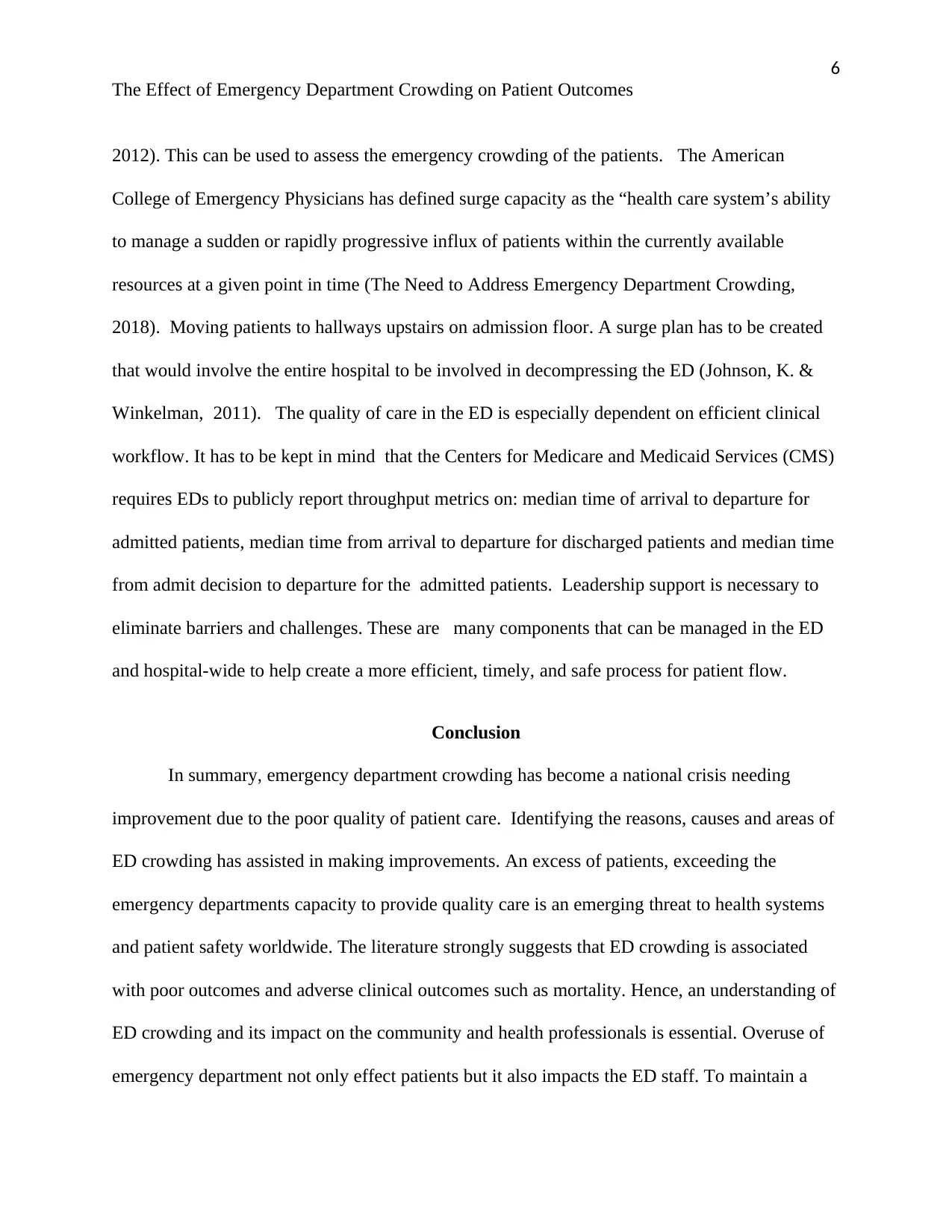
6
The Effect of Emergency Department Crowding on Patient Outcomes
2012). This can be used to assess the emergency crowding of the patients. The American
College of Emergency Physicians has defined surge capacity as the “health care system’s ability
to manage a sudden or rapidly progressive influx of patients within the currently available
resources at a given point in time (The Need to Address Emergency Department Crowding,
2018). Moving patients to hallways upstairs on admission floor. A surge plan has to be created
that would involve the entire hospital to be involved in decompressing the ED (Johnson, K. &
Winkelman, 2011). The quality of care in the ED is especially dependent on efficient clinical
workflow. It has to be kept in mind that the Centers for Medicare and Medicaid Services (CMS)
requires EDs to publicly report throughput metrics on: median time of arrival to departure for
admitted patients, median time from arrival to departure for discharged patients and median time
from admit decision to departure for the admitted patients. Leadership support is necessary to
eliminate barriers and challenges. These are many components that can be managed in the ED
and hospital-wide to help create a more efficient, timely, and safe process for patient flow.
Conclusion
In summary, emergency department crowding has become a national crisis needing
improvement due to the poor quality of patient care. Identifying the reasons, causes and areas of
ED crowding has assisted in making improvements. An excess of patients, exceeding the
emergency departments capacity to provide quality care is an emerging threat to health systems
and patient safety worldwide. The literature strongly suggests that ED crowding is associated
with poor outcomes and adverse clinical outcomes such as mortality. Hence, an understanding of
ED crowding and its impact on the community and health professionals is essential. Overuse of
emergency department not only effect patients but it also impacts the ED staff. To maintain a
The Effect of Emergency Department Crowding on Patient Outcomes
2012). This can be used to assess the emergency crowding of the patients. The American
College of Emergency Physicians has defined surge capacity as the “health care system’s ability
to manage a sudden or rapidly progressive influx of patients within the currently available
resources at a given point in time (The Need to Address Emergency Department Crowding,
2018). Moving patients to hallways upstairs on admission floor. A surge plan has to be created
that would involve the entire hospital to be involved in decompressing the ED (Johnson, K. &
Winkelman, 2011). The quality of care in the ED is especially dependent on efficient clinical
workflow. It has to be kept in mind that the Centers for Medicare and Medicaid Services (CMS)
requires EDs to publicly report throughput metrics on: median time of arrival to departure for
admitted patients, median time from arrival to departure for discharged patients and median time
from admit decision to departure for the admitted patients. Leadership support is necessary to
eliminate barriers and challenges. These are many components that can be managed in the ED
and hospital-wide to help create a more efficient, timely, and safe process for patient flow.
Conclusion
In summary, emergency department crowding has become a national crisis needing
improvement due to the poor quality of patient care. Identifying the reasons, causes and areas of
ED crowding has assisted in making improvements. An excess of patients, exceeding the
emergency departments capacity to provide quality care is an emerging threat to health systems
and patient safety worldwide. The literature strongly suggests that ED crowding is associated
with poor outcomes and adverse clinical outcomes such as mortality. Hence, an understanding of
ED crowding and its impact on the community and health professionals is essential. Overuse of
emergency department not only effect patients but it also impacts the ED staff. To maintain a
⊘ This is a preview!⊘
Do you want full access?
Subscribe today to unlock all pages.

Trusted by 1+ million students worldwide

7
The Effect of Emergency Department Crowding on Patient Outcomes
smooth flow of patient in and out of the emergency department staff must be able to control the
chaotic environment. To alleviate crowding and better ensure safety of ED patients, communities
must tackle the crisis with a multidisciplinary system wide approach.
References
Boyle, A., Beniuk, K., Higginson, I., & Atkinson, P. (2012). Emergency department crowding:
time for interventions and policy evaluations. Emergency medicine international, 2012.
Carlson, K. (2016). Crowding in the Emergency Department. Journal of Emergency Nursing ,
Volume 42 , Issue 2 , 97 - 98
Centers for Disease Control and Prevention. [Retrieved February 26, 2019]; FastStats. Hospital
utilization. 2009 Retrieved from:
http://www.cdc.gov/nchs/data/ahcd/nhamcs_emergency/2009_ed_web_tables.pdf.
Emergency Nurses Association. (2017). ENA topic brief: Emergency department throughput.
Des Plaines, IL: Emergency Nurses Association. Retrieved from
https://www.ena.org/docs/default-source/resource-library/practice- resources/topic-
briefs/ed throughput.pdf
The Effect of Emergency Department Crowding on Patient Outcomes
smooth flow of patient in and out of the emergency department staff must be able to control the
chaotic environment. To alleviate crowding and better ensure safety of ED patients, communities
must tackle the crisis with a multidisciplinary system wide approach.
References
Boyle, A., Beniuk, K., Higginson, I., & Atkinson, P. (2012). Emergency department crowding:
time for interventions and policy evaluations. Emergency medicine international, 2012.
Carlson, K. (2016). Crowding in the Emergency Department. Journal of Emergency Nursing ,
Volume 42 , Issue 2 , 97 - 98
Centers for Disease Control and Prevention. [Retrieved February 26, 2019]; FastStats. Hospital
utilization. 2009 Retrieved from:
http://www.cdc.gov/nchs/data/ahcd/nhamcs_emergency/2009_ed_web_tables.pdf.
Emergency Nurses Association. (2017). ENA topic brief: Emergency department throughput.
Des Plaines, IL: Emergency Nurses Association. Retrieved from
https://www.ena.org/docs/default-source/resource-library/practice- resources/topic-
briefs/ed throughput.pdf
Paraphrase This Document
Need a fresh take? Get an instant paraphrase of this document with our AI Paraphraser
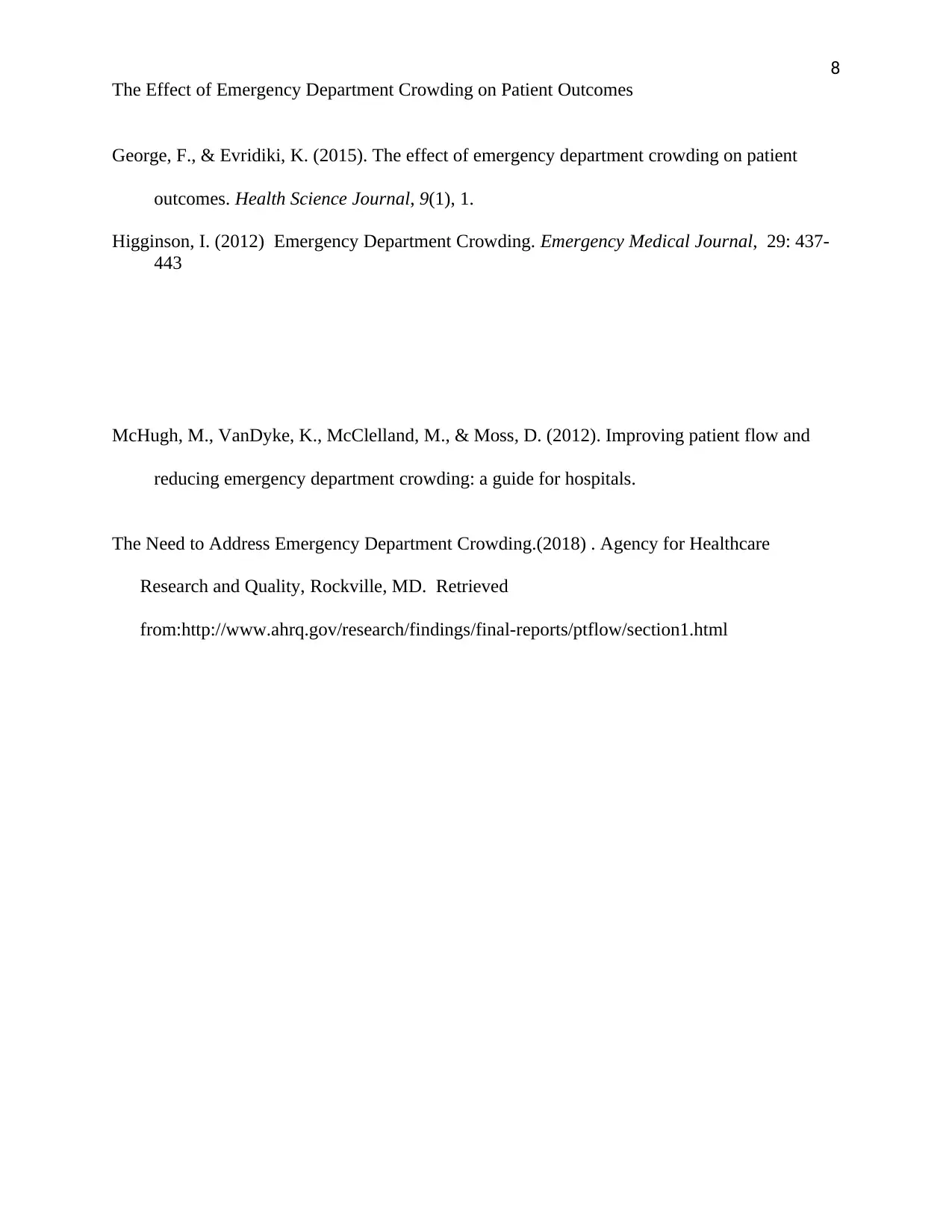
8
The Effect of Emergency Department Crowding on Patient Outcomes
George, F., & Evridiki, K. (2015). The effect of emergency department crowding on patient
outcomes. Health Science Journal, 9(1), 1.
Higginson, I. (2012) Emergency Department Crowding. Emergency Medical Journal, 29: 437-
443
McHugh, M., VanDyke, K., McClelland, M., & Moss, D. (2012). Improving patient flow and
reducing emergency department crowding: a guide for hospitals.
The Need to Address Emergency Department Crowding.(2018) . Agency for Healthcare
Research and Quality, Rockville, MD. Retrieved
from:http://www.ahrq.gov/research/findings/final-reports/ptflow/section1.html
The Effect of Emergency Department Crowding on Patient Outcomes
George, F., & Evridiki, K. (2015). The effect of emergency department crowding on patient
outcomes. Health Science Journal, 9(1), 1.
Higginson, I. (2012) Emergency Department Crowding. Emergency Medical Journal, 29: 437-
443
McHugh, M., VanDyke, K., McClelland, M., & Moss, D. (2012). Improving patient flow and
reducing emergency department crowding: a guide for hospitals.
The Need to Address Emergency Department Crowding.(2018) . Agency for Healthcare
Research and Quality, Rockville, MD. Retrieved
from:http://www.ahrq.gov/research/findings/final-reports/ptflow/section1.html
1 out of 8
Related Documents
Your All-in-One AI-Powered Toolkit for Academic Success.
+13062052269
info@desklib.com
Available 24*7 on WhatsApp / Email
![[object Object]](/_next/static/media/star-bottom.7253800d.svg)
Unlock your academic potential
Copyright © 2020–2025 A2Z Services. All Rights Reserved. Developed and managed by ZUCOL.





